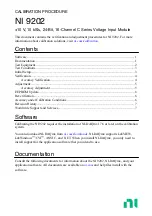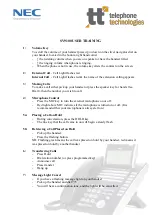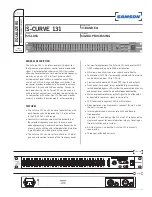
Q: Does the transmitter connect to the amplified speaker output of my surround sound
receiver?
A:
The transmitter cannot be connected to an amplified speaker output. For this application, we
recommend the Model 1520 and Model 1550 transmitter / amplifiers.
Q: Is the technology used similar to Bluetooth or MP3?
A:
Even though both our transmitter / receiver and Bluetooth / MP3 use digital audio, there is a
fundamental difference between Bluetooth and how audio is transmitted by our transmitter.
Bluetooth is only able to transmit audio data at very low data rates reliably (typically up to 200 kbps).
Therefore, only compressed audio can be transmitted via Bluetooth. A commonly used technique to
compress audio data is MP3. Our transmitter, however, does not compress the audio and transmits
the full bit rate. As a result, the audio quality is not degraded such as with MP3. Also, the audio
latency (audio delay) of MP3 compressed audio is fairly high and thus not suitable for television or
video applications. Since our transmitter does not compress the audio and since only a minimum of
data buffering is used, the audio delay is minimal.
Q: What does the noise shaping filter do which is part of the audio receiver ?
A:
Digital audio, such as audio on a CD and the audio transmitted to the receiver, is represented by
numbers that represent voltage levels. When analog audio is converted to digital audio, the voltage
of the audio signal is sampled and represented by a number that refers to the voltage that comes
closest to the actual voltage. Because there is usually a small difference between that voltage and
the actual voltage of the analog audio signal, a certain amount of noise - quantization noise - is
introduced. The amount of such quantization noise is, among other things, determined by the
amount of information that is used to represent each sample - resolution. Therefore, digital audio on
a CD and audio transmitted to the receiver always contains a small amount of quantization noise
which limits the maximum possible signal-to-noise ratio of the transmission. In order to increase the
signal-to-noise ration beyond that limit, the receiver features a special noise shaping filter which is a
5th-order filter that outputs the audio at 64 times the sampling frequency and shifts the audio data
quantization noise to higher frequencies that are outside of the audible frequency band. As a result,
the receiver is able to achieve a higher signal-to-noise ratio than would be possible without a noise
shaping filter.
Q: What is Forward Error Correction and why is it used by the transmitter / receiver ?
A:
Occasionally, there may be some data which is corrupted during transmission. This may be the
case when there is interference, such as other transmitters, electrical sparks or if you move around
and the signal is temporarily lost. Forward Error Correction as it is used by the transmitter / receiver
can in most cases repair the data which is received to guarantee 100% correct data reception and
therefore 100% correct audio reception.
This technology is in part responsible for the high robustness of the transmission. With analog audio
transmitters you may have noticed ‘clicks’ or ‘pops’ during sparks which often occur when switching
on appliances.
© 2004 Amphony 2





















